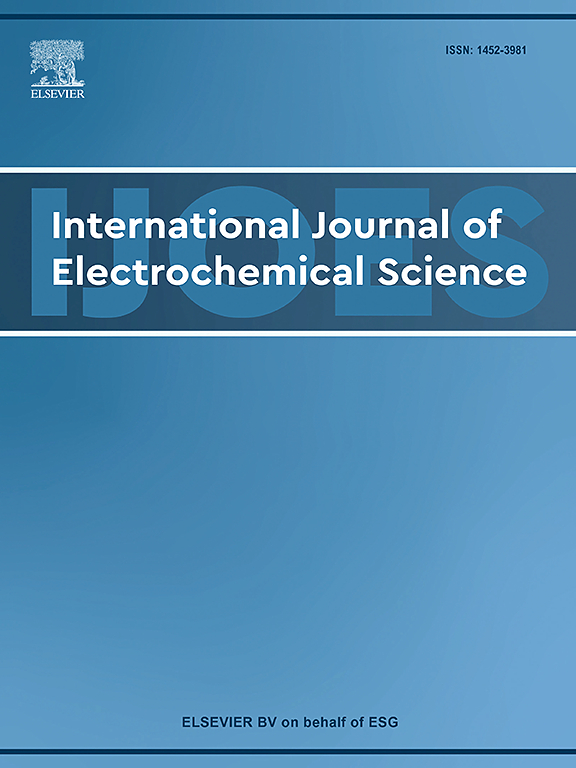Ni-decorated porous dendritic Cu film on Cu foam for enhanced hydrazine oxidation catalysis
IF 2.4
4区 化学
Q4 ELECTROCHEMISTRY
International Journal of Electrochemical Science
Pub Date : 2025-07-28
DOI:10.1016/j.ijoes.2025.101142
引用次数: 0
Abstract
Two major challenges limit the widespread use of direct hydrazine fuel cells (DHFCs): slow hydrazine oxidation reaction (HzOR) kinetics and the reliance on expensive noble-metal catalysts. To overcome these limitations, a Ni-Cu film/Cu foam (CF) electrode was developed through a two-stage electrochemical deposition approach. This process involved initially depositing a three-dimensional (3D) porous dendritic Cu film onto a CF substrate (denoted as Cu film/CF), followed by the controlled electrodeposition of Ni nanoparticles onto the prepared Cu film. The well-designed Ni-Cu film/CF electrode demonstrated noticeable superiority in terms of catalytic activity over single-metal electrodes and commercial Pt/C catalyst, displaying a current density (j) of 295.1 mA cm−2 at −0.65 V and an onset potential (Eon) of −1.1 V. Electrochemical kinetic parameters were determined, revealing that the Ni-Cu film/CF electrode exhibited a reduced activation energy (Ea), diminished charge-transfer resistance (Rct), and an increased electrochemically active surface area (ECSA) compared to its monometallic electrodes. The electrocatalytic performance enhancement stems from the unique 3D porous dendritic shape of the Ni-Cu film/CF electrode in conjunction with synergistic Ni-Cu effect, which promotes electron transport, facilitates accessibility to catalytic sites, and optimizes HzOR kinetics.
Cu泡沫上ni修饰多孔枝晶Cu膜增强肼氧化催化作用
两个主要的挑战限制了直接肼燃料电池(dhfc)的广泛使用:缓慢的肼氧化反应(HzOR)动力学和对昂贵的贵金属催化剂的依赖。为了克服这些限制,通过两阶段电化学沉积方法开发了Ni-Cu膜/Cu泡沫(CF)电极。该工艺包括首先在CF衬底上沉积三维(3D)多孔枝晶Cu膜(表示为Cu膜/CF),然后在制备的Cu膜上控制镍纳米粒子的电沉积。设计良好的Ni-Cu膜/CF电极在催化活性方面明显优于单金属电极和商用Pt/C催化剂,在−0.65 V下电流密度(j)为295.1 mA cm−2,起始电位(Eon)为−1.1 V。电化学动力学参数的测定表明,与单金属电极相比,Ni-Cu膜/CF电极的活化能(Ea)降低,电荷转移电阻(Rct)降低,电化学活性表面积(ECSA)增加。电催化性能的增强源于Ni-Cu膜/CF电极独特的3D多孔枝晶形状,以及协同Ni-Cu效应,促进了电子传递,促进了催化位点的可达性,并优化了HzOR动力学。
本文章由计算机程序翻译,如有差异,请以英文原文为准。
求助全文
约1分钟内获得全文
求助全文
来源期刊
CiteScore
3.00
自引率
20.00%
发文量
714
审稿时长
2.6 months
期刊介绍:
International Journal of Electrochemical Science is a peer-reviewed, open access journal that publishes original research articles, short communications as well as review articles in all areas of electrochemistry: Scope - Theoretical and Computational Electrochemistry - Processes on Electrodes - Electroanalytical Chemistry and Sensor Science - Corrosion - Electrochemical Energy Conversion and Storage - Electrochemical Engineering - Coatings - Electrochemical Synthesis - Bioelectrochemistry - Molecular Electrochemistry

 求助内容:
求助内容: 应助结果提醒方式:
应助结果提醒方式:


